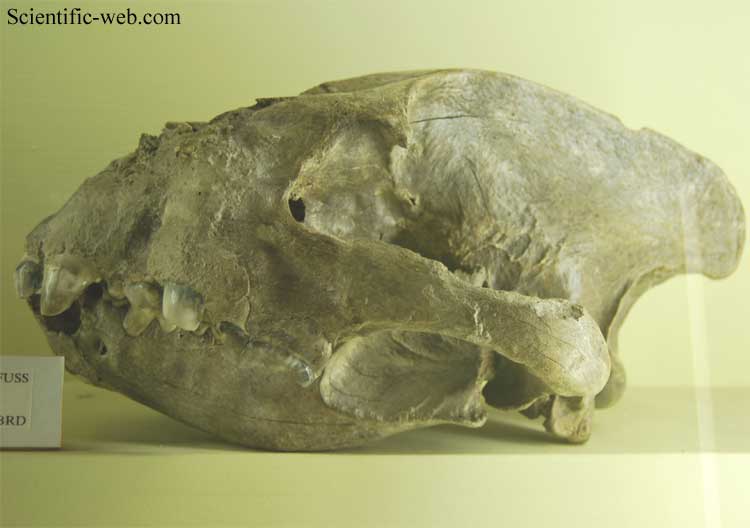Crocuta crocuta spelaea, Photo: Michael Lahanas Cladus: Eukaryota The Cave Hyena (Crocuta crocuta spelaea) is an extinct subspecies of spotted hyena (Crocuta crocuta) native to Eurasia, ranging from Northern China to Spain and into the British Isles. Though originally described as a separate species from the spotted hyena due to large differences in fore and hind extremities, genetic analysis indicates no sizeable differences in DNA between Pleistocene cave hyena and modern day spotted hyena populations.[1][2] It is known from a range of fossils and prehistoric cave art. With the decline of grasslands 12,500 years ago, Europe experienced a massive loss of lowland habitats favoured by cave hyenas, and a corresponding increase in mixed woodlands. Cave hyenas, under these circumstances, would have been outcompeted by wolves and humans which were as much at home in forests as in open lands, and in highlands as in lowlands. Cave hyena populations began to shrink after roughly 20,000 years ago, completely disappearing from Western Europe between 14-11,000 years ago, and earlier in some areas.[3]
The main distinction between the spotted hyena and the cave hyena is grounded on different lengths of the hind and fore limb bones. The humerus and femur are longer in the cave hyena, indicating an adaptation to a different habitat to that of the spotted hyena. It is unknown if they showed the same sexual dimorphism of the spotted hyena.[1] It has been estimated that they weighed 102 kg (225 lbs).[4] Little is known of their social habits. It is widely accepted that they used caves as dens, although sites in the open-air are also known.[5] There is no indication of cave hyenas living in large clans or on a more solitary basis, though large clans are not considered likely in their Pleistocene habitat.[1] Dietary habits Like modern hyenas, cave hyenas accumulated the bones and horns of their food at den sites for later consumption or for play, though it is unknown if the discovered remains were from scavenged or killed animals. Studies of animal remains in hyena den sites in the Bohemian Karst show that Przewalski's Horses were apparently their most common prey, which amounted to 16-51% of the cave hyena's prey. Their largest prey was the woolly rhinoceros, the bones and skulls of which have been found in many hyena den sites. In some regions, rhino remains can comprise 25-30% of the total prey bone material in den sites. Reindeer were another important food source, as they made up 7-15% of the cave hyena's prey. The Steppe Wisent made up only 1-6% of the cave hyena's prey. Red deer only comprised 3% of found remains, with Irish elk being even rarer. The remains of alpine fauna including chamois and ibex are absent in some places, representing less than 3% of the prey, possibly due to their greater fragility.[5] There is evidence that cave hyenas occasionally practiced cannibalism.[5] Interspecific predatory relationships Cave hyenas were highly successful predators, and were especially numerous in Northeast Asia, where it seems they outcompeted most other predators. This was deduced from the relative scarcity of cave lion, cave bear and wolf remains in areas where they are sympatric with hyenas.[6] Cave hyenas are thought to be responsible for the dis-articulation and destruction of some cave bear skeletons. Such large carcasses were an optimal food resource for the hyenas, especially at the end of the winter, when food was scarce.[5] Cave hyenas were sympatric with gray wolves in Italy. Unlike the hyenas, which preferentially preyed on lowland animals such as horses, wolves relied more on smaller, slope-dwelling prey such as ibex and roe deer, thus minimizing competition. Wolves and cave hyenas seem to display negative abundance relations over time, with wolf populations expanding their ranges as hyenas disappeared. [3] Interactions with hominids Kills partially processed by Neanderthal and then by cave hyena indicate that hyena would occasionally steal Neanderthal kills, and cave hyena and Neanderthal both competed for cave sites. Many caves show alternating occupations of hyenas and Neanderthals.[7] Numerous hominid bones, including Neanderthal, have also been found partially consumed by cave hyena. Modern humans also lived alongside cave hyena, and may have had similar interaction with them. Some paleontologists believe that competition and predation by cave hyenas in Siberia was a significant factor in delaying human colonization of Alaska. Cave hyenas may have occasionally stolen human kills, or entered campsites to drag off the young and weak, much like modern spotted hyenas in Africa. The oldest Alaskan human remains coincide with roughly the same time cave hyenas became extinct, leading certain paleontologists to infer that hyena predation was what prevented humans from crossing the Bering strait earlier.[6] References 1. ^ a b c "Comparison of Crocuta crocuta crocuta and Crocuta crocuta spelaea through computertomography". Dockner, Martin. Department of Paleontology, University of Vienna. http://www.oeaw.ac.at/kfq/hyaenas/thesis.pdf. Retrieved 2008-01-20. Source: Wikipedia, Wikispecies: All text is available under the terms of the GNU Free Documentation License |
|


